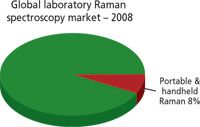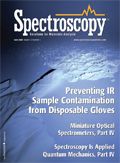Market Profile: Portable and Handheld Raman
The continuing pace of technological advancements in scientific instruments has recently led to a wide range of commercially viable portable and handheld instruments, and the Raman spectroscopy market is no exception. While security applications have received much of the early attention in relation to handheld instruments, other applications are beginning to replace demand from the security markets.
The continuing pace of technological advancements in scientific instruments has recently led to a wide range of commercially viable portable and handheld instruments, and the Raman spectroscopy market is no exception. While security applications have received much of the early attention in relation to handheld instruments, other applications are beginning to replace demand from the security markets.

Global laboratory Raman spectroscopy market â 2008
Technological advancements have been the primary driver of the overall Raman spectroscopy market, which has been developing rapidly into a major instrument market from one that was relatively obscure not much more than a decade ago. Improvements in lasers, fiber optics, filters, and batteries, combined with their miniaturization, has allowed for more than a half dozen new introductions of handheld and portable Raman instruments within the past two years.
Military and homeland security applications have, until now, been the primary drivers of demand for such instruments. As with many other technologies, significant government funding has helped with commercial development of portable Raman instrumentation, which is now beginning to see the rise of demand from industry. Inspection of incoming materials, at-line analysis, and anti-counterfeiting are major areas of application within the pharmaceutical industry, and other applications, such as mineral analysis in geology, are on the rise as well.
SDi estimates that worldwide sales for handheld and portable Raman spectrometers will top $10 million in 2008, coming from the more than half dozen vendors that now participate in this market space. The strong double-digit growth of this area will be a major driver of the wider laboratory Raman market.
The foregoing data were based upon SDi's market analysis and perspectives report entitled Edition Global Assessment Report, 9th Edition: The Laboratory Life Science and Analytical Instrument Industry, September 2006. For more information, contact Stuart Press, Senior Consultant, Strategic Directions International, Inc., 6242 Westchester Parkway, Suite 100, Los Angeles, CA 90045, (310) 641-4982, fax: (310) 641-8851, www.strategic-directions.com.

AI-Powered SERS Spectroscopy Breakthrough Boosts Safety of Medicinal Food Products
April 16th 2025A new deep learning-enhanced spectroscopic platform—SERSome—developed by researchers in China and Finland, identifies medicinal and edible homologs (MEHs) with 98% accuracy. This innovation could revolutionize safety and quality control in the growing MEH market.
New Raman Spectroscopy Method Enhances Real-Time Monitoring Across Fermentation Processes
April 15th 2025Researchers at Delft University of Technology have developed a novel method using single compound spectra to enhance the transferability and accuracy of Raman spectroscopy models for real-time fermentation monitoring.
Nanometer-Scale Studies Using Tip Enhanced Raman Spectroscopy
February 8th 2013Volker Deckert, the winner of the 2013 Charles Mann Award, is advancing the use of tip enhanced Raman spectroscopy (TERS) to push the lateral resolution of vibrational spectroscopy well below the Abbe limit, to achieve single-molecule sensitivity. Because the tip can be moved with sub-nanometer precision, structural information with unmatched spatial resolution can be achieved without the need of specific labels.